Analysis of Defamation and Misleading Conduct Case Study
VerifiedAdded on 2020/03/01
|9
|1950
|35
Report
AI Summary
This report provides an analysis of a defamation case involving Denise Denefew, a former Olympic swimmer and solicitor, and Will Smear, who published a blog post containing allegedly defamatory information about her treatment for a mild obsessive-compulsive disorder. The report examines the legal issues of defamation, focusing on misleading conduct and economic torts, and explores the legal defenses available to Will Smear and iNyouEndO, an online media organization. The report references the Defamation Act 2005 and relevant case law, including Cornes v The Ten Group Pty Ltd & Ors, Howden v ‘Truth’ & ‘Sportsman’ Ltd, and JONES vs. SKELTON. The analysis covers the elements of defamation, including the publication of false statements that harm reputation, and discusses defenses such as justification, fair comment, and qualified privilege. The report concludes that both Will Smear and iNyouEndO can potentially use defenses under the Defamation Act 2005, given the specific facts and circumstances of the case.
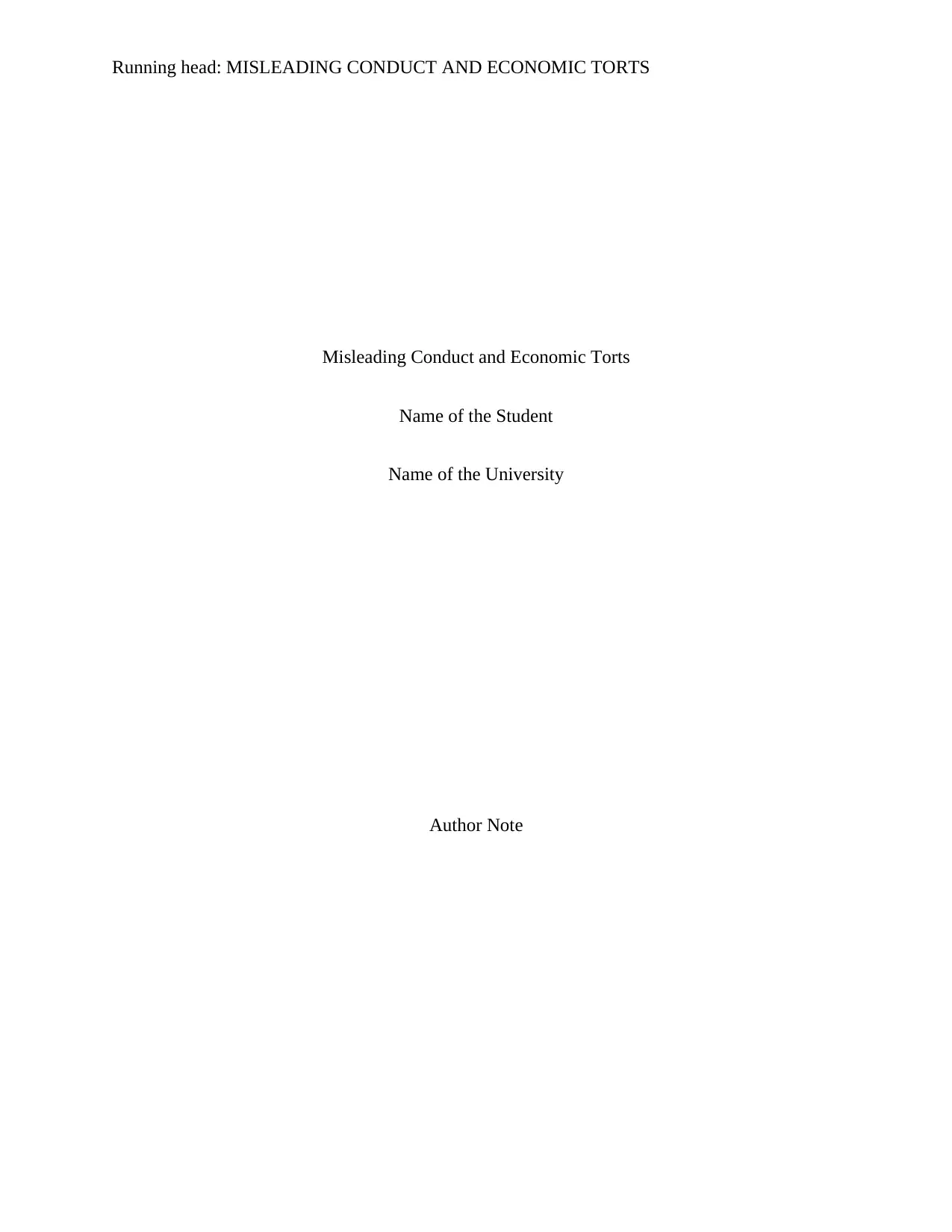
Running head: MISLEADING CONDUCT AND ECONOMIC TORTS
Misleading Conduct and Economic Torts
Name of the Student
Name of the University
Author Note
Misleading Conduct and Economic Torts
Name of the Student
Name of the University
Author Note
Paraphrase This Document
Need a fresh take? Get an instant paraphrase of this document with our AI Paraphraser
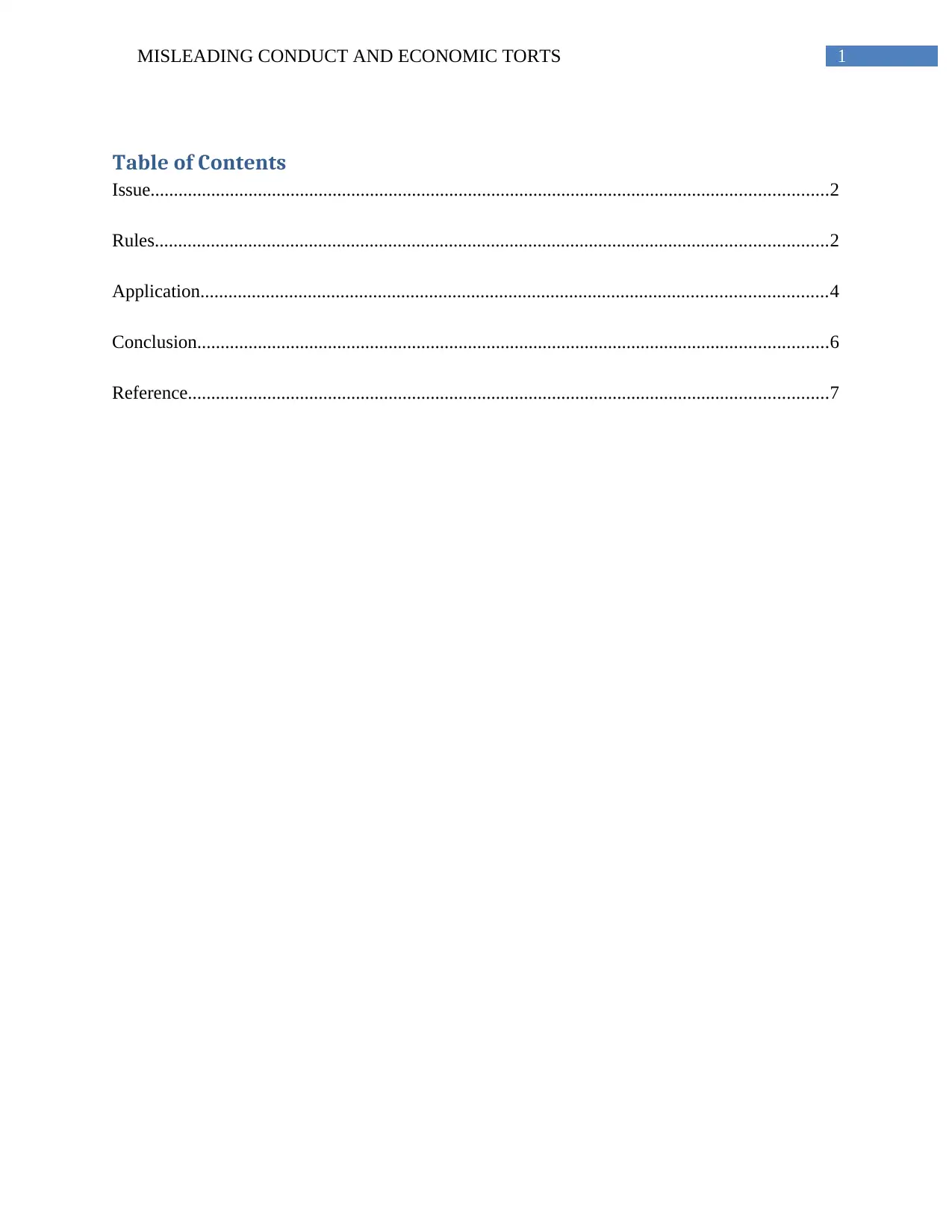
1MISLEADING CONDUCT AND ECONOMIC TORTS
Table of Contents
Issue.................................................................................................................................................2
Rules................................................................................................................................................2
Application......................................................................................................................................4
Conclusion.......................................................................................................................................6
Reference.........................................................................................................................................7
Table of Contents
Issue.................................................................................................................................................2
Rules................................................................................................................................................2
Application......................................................................................................................................4
Conclusion.......................................................................................................................................6
Reference.........................................................................................................................................7
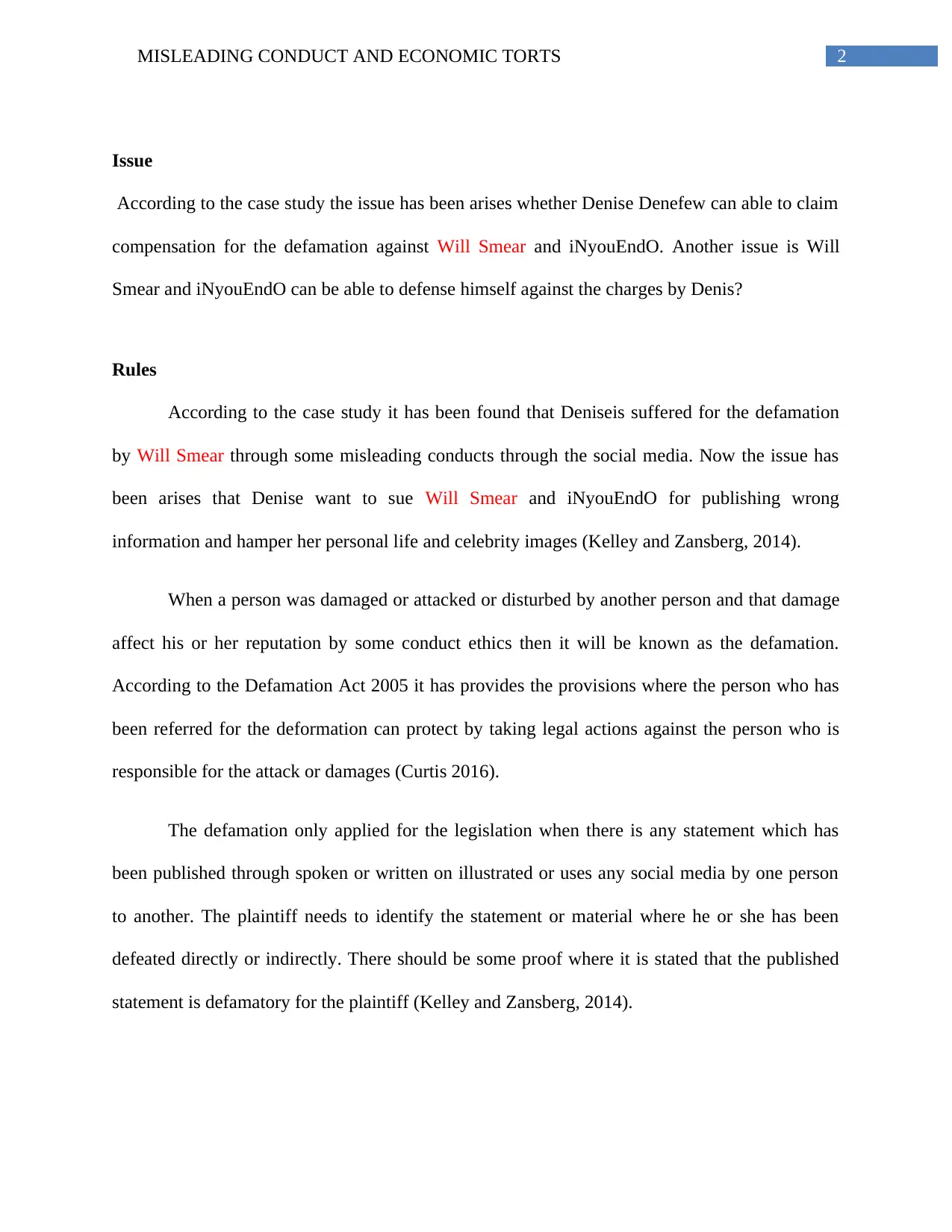
2MISLEADING CONDUCT AND ECONOMIC TORTS
Issue
According to the case study the issue has been arises whether Denise Denefew can able to claim
compensation for the defamation against Will Smear and iNyouEndO. Another issue is Will
Smear and iNyouEndO can be able to defense himself against the charges by Denis?
Rules
According to the case study it has been found that Deniseis suffered for the defamation
by Will Smear through some misleading conducts through the social media. Now the issue has
been arises that Denise want to sue Will Smear and iNyouEndO for publishing wrong
information and hamper her personal life and celebrity images (Kelley and Zansberg, 2014).
When a person was damaged or attacked or disturbed by another person and that damage
affect his or her reputation by some conduct ethics then it will be known as the defamation.
According to the Defamation Act 2005 it has provides the provisions where the person who has
been referred for the deformation can protect by taking legal actions against the person who is
responsible for the attack or damages (Curtis 2016).
The defamation only applied for the legislation when there is any statement which has
been published through spoken or written on illustrated or uses any social media by one person
to another. The plaintiff needs to identify the statement or material where he or she has been
defeated directly or indirectly. There should be some proof where it is stated that the published
statement is defamatory for the plaintiff (Kelley and Zansberg, 2014).
Issue
According to the case study the issue has been arises whether Denise Denefew can able to claim
compensation for the defamation against Will Smear and iNyouEndO. Another issue is Will
Smear and iNyouEndO can be able to defense himself against the charges by Denis?
Rules
According to the case study it has been found that Deniseis suffered for the defamation
by Will Smear through some misleading conducts through the social media. Now the issue has
been arises that Denise want to sue Will Smear and iNyouEndO for publishing wrong
information and hamper her personal life and celebrity images (Kelley and Zansberg, 2014).
When a person was damaged or attacked or disturbed by another person and that damage
affect his or her reputation by some conduct ethics then it will be known as the defamation.
According to the Defamation Act 2005 it has provides the provisions where the person who has
been referred for the deformation can protect by taking legal actions against the person who is
responsible for the attack or damages (Curtis 2016).
The defamation only applied for the legislation when there is any statement which has
been published through spoken or written on illustrated or uses any social media by one person
to another. The plaintiff needs to identify the statement or material where he or she has been
defeated directly or indirectly. There should be some proof where it is stated that the published
statement is defamatory for the plaintiff (Kelley and Zansberg, 2014).
⊘ This is a preview!⊘
Do you want full access?
Subscribe today to unlock all pages.

Trusted by 1+ million students worldwide
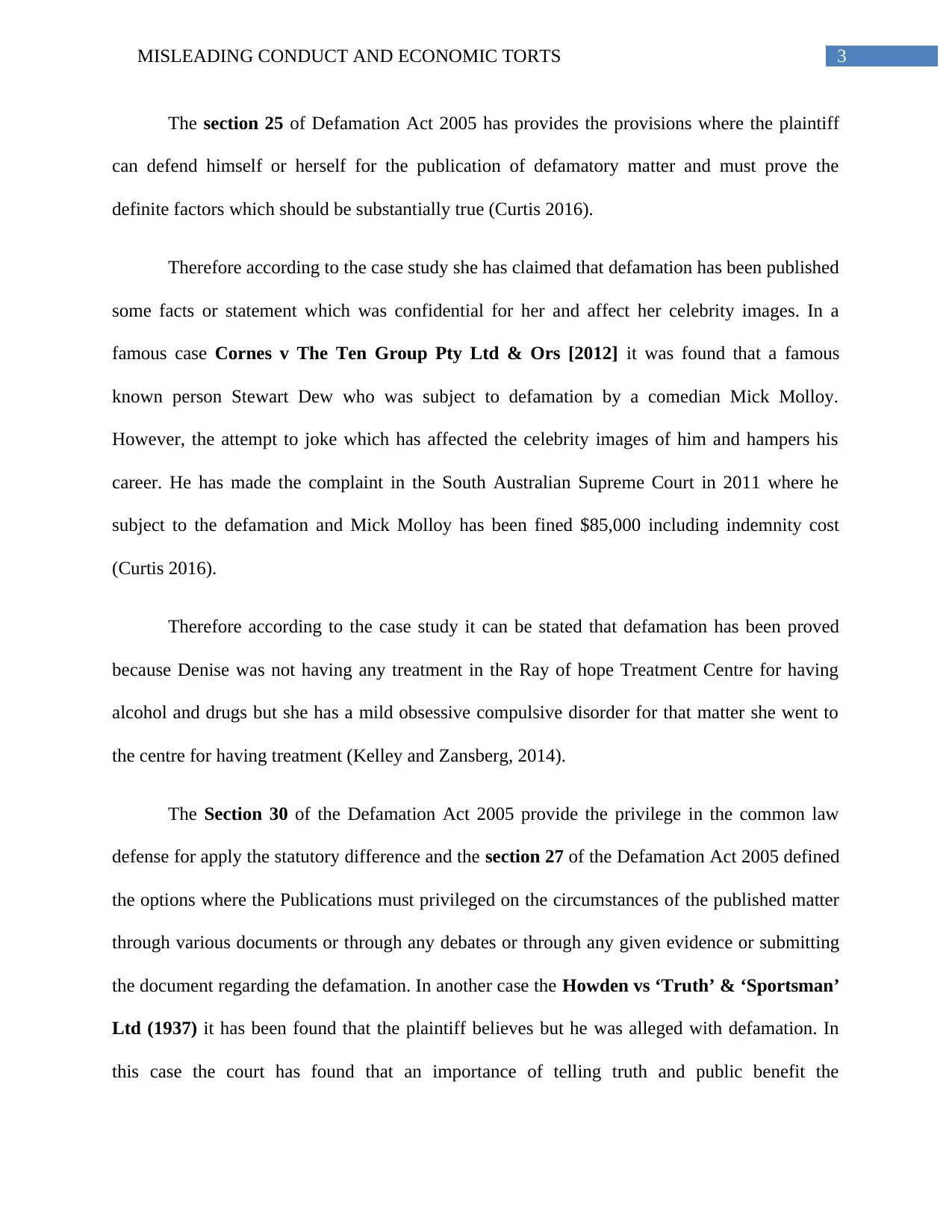
3MISLEADING CONDUCT AND ECONOMIC TORTS
The section 25 of Defamation Act 2005 has provides the provisions where the plaintiff
can defend himself or herself for the publication of defamatory matter and must prove the
definite factors which should be substantially true (Curtis 2016).
Therefore according to the case study she has claimed that defamation has been published
some facts or statement which was confidential for her and affect her celebrity images. In a
famous case Cornes v The Ten Group Pty Ltd & Ors [2012] it was found that a famous
known person Stewart Dew who was subject to defamation by a comedian Mick Molloy.
However, the attempt to joke which has affected the celebrity images of him and hampers his
career. He has made the complaint in the South Australian Supreme Court in 2011 where he
subject to the defamation and Mick Molloy has been fined $85,000 including indemnity cost
(Curtis 2016).
Therefore according to the case study it can be stated that defamation has been proved
because Denise was not having any treatment in the Ray of hope Treatment Centre for having
alcohol and drugs but she has a mild obsessive compulsive disorder for that matter she went to
the centre for having treatment (Kelley and Zansberg, 2014).
The Section 30 of the Defamation Act 2005 provide the privilege in the common law
defense for apply the statutory difference and the section 27 of the Defamation Act 2005 defined
the options where the Publications must privileged on the circumstances of the published matter
through various documents or through any debates or through any given evidence or submitting
the document regarding the defamation. In another case the Howden vs ‘Truth’ & ‘Sportsman’
Ltd (1937) it has been found that the plaintiff believes but he was alleged with defamation. In
this case the court has found that an importance of telling truth and public benefit the
The section 25 of Defamation Act 2005 has provides the provisions where the plaintiff
can defend himself or herself for the publication of defamatory matter and must prove the
definite factors which should be substantially true (Curtis 2016).
Therefore according to the case study she has claimed that defamation has been published
some facts or statement which was confidential for her and affect her celebrity images. In a
famous case Cornes v The Ten Group Pty Ltd & Ors [2012] it was found that a famous
known person Stewart Dew who was subject to defamation by a comedian Mick Molloy.
However, the attempt to joke which has affected the celebrity images of him and hampers his
career. He has made the complaint in the South Australian Supreme Court in 2011 where he
subject to the defamation and Mick Molloy has been fined $85,000 including indemnity cost
(Curtis 2016).
Therefore according to the case study it can be stated that defamation has been proved
because Denise was not having any treatment in the Ray of hope Treatment Centre for having
alcohol and drugs but she has a mild obsessive compulsive disorder for that matter she went to
the centre for having treatment (Kelley and Zansberg, 2014).
The Section 30 of the Defamation Act 2005 provide the privilege in the common law
defense for apply the statutory difference and the section 27 of the Defamation Act 2005 defined
the options where the Publications must privileged on the circumstances of the published matter
through various documents or through any debates or through any given evidence or submitting
the document regarding the defamation. In another case the Howden vs ‘Truth’ & ‘Sportsman’
Ltd (1937) it has been found that the plaintiff believes but he was alleged with defamation. In
this case the court has found that an importance of telling truth and public benefit the
Paraphrase This Document
Need a fresh take? Get an instant paraphrase of this document with our AI Paraphraser
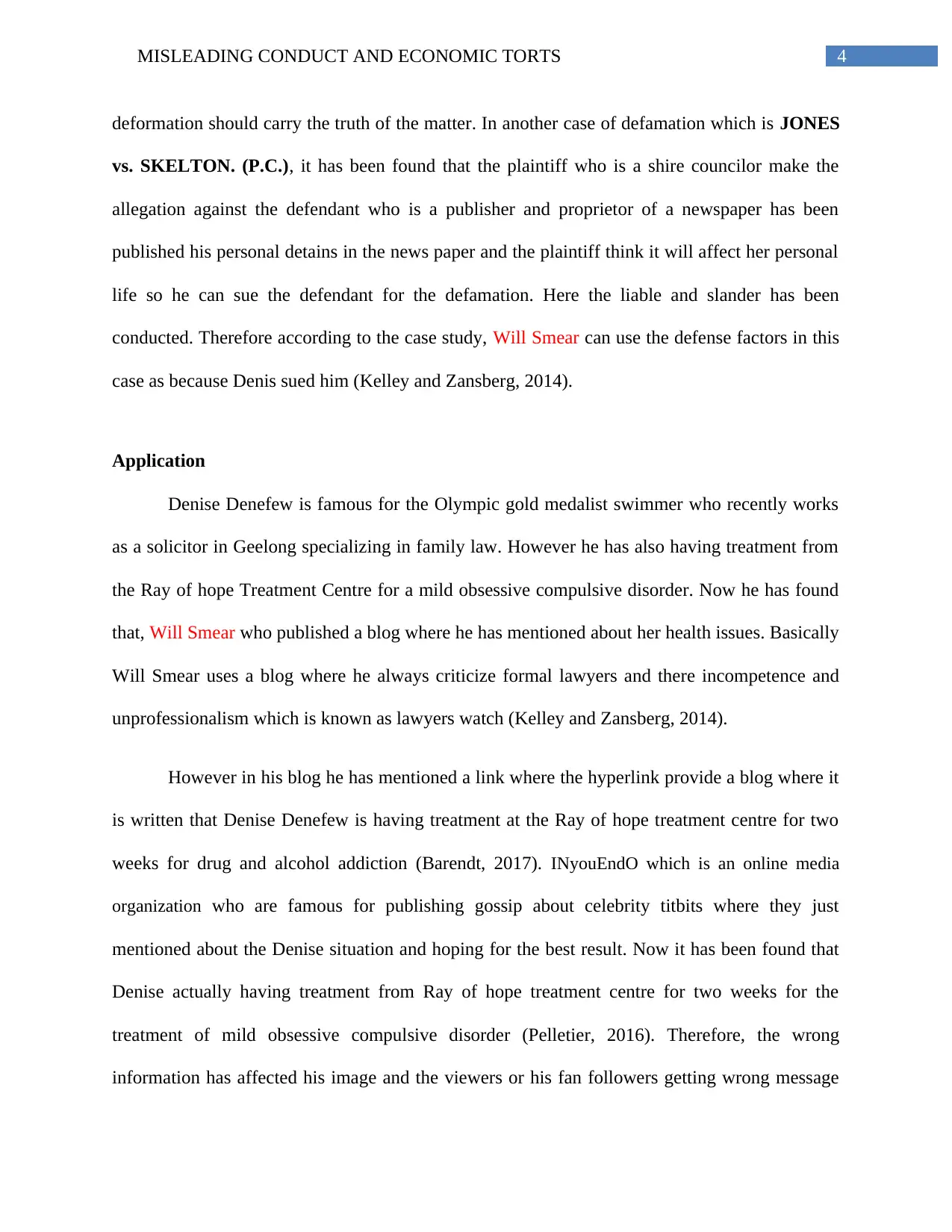
4MISLEADING CONDUCT AND ECONOMIC TORTS
deformation should carry the truth of the matter. In another case of defamation which is JONES
vs. SKELTON. (P.C.), it has been found that the plaintiff who is a shire councilor make the
allegation against the defendant who is a publisher and proprietor of a newspaper has been
published his personal detains in the news paper and the plaintiff think it will affect her personal
life so he can sue the defendant for the defamation. Here the liable and slander has been
conducted. Therefore according to the case study, Will Smear can use the defense factors in this
case as because Denis sued him (Kelley and Zansberg, 2014).
Application
Denise Denefew is famous for the Olympic gold medalist swimmer who recently works
as a solicitor in Geelong specializing in family law. However he has also having treatment from
the Ray of hope Treatment Centre for a mild obsessive compulsive disorder. Now he has found
that, Will Smear who published a blog where he has mentioned about her health issues. Basically
Will Smear uses a blog where he always criticize formal lawyers and there incompetence and
unprofessionalism which is known as lawyers watch (Kelley and Zansberg, 2014).
However in his blog he has mentioned a link where the hyperlink provide a blog where it
is written that Denise Denefew is having treatment at the Ray of hope treatment centre for two
weeks for drug and alcohol addiction (Barendt, 2017). INyouEndO which is an online media
organization who are famous for publishing gossip about celebrity titbits where they just
mentioned about the Denise situation and hoping for the best result. Now it has been found that
Denise actually having treatment from Ray of hope treatment centre for two weeks for the
treatment of mild obsessive compulsive disorder (Pelletier, 2016). Therefore, the wrong
information has affected his image and the viewers or his fan followers getting wrong message
deformation should carry the truth of the matter. In another case of defamation which is JONES
vs. SKELTON. (P.C.), it has been found that the plaintiff who is a shire councilor make the
allegation against the defendant who is a publisher and proprietor of a newspaper has been
published his personal detains in the news paper and the plaintiff think it will affect her personal
life so he can sue the defendant for the defamation. Here the liable and slander has been
conducted. Therefore according to the case study, Will Smear can use the defense factors in this
case as because Denis sued him (Kelley and Zansberg, 2014).
Application
Denise Denefew is famous for the Olympic gold medalist swimmer who recently works
as a solicitor in Geelong specializing in family law. However he has also having treatment from
the Ray of hope Treatment Centre for a mild obsessive compulsive disorder. Now he has found
that, Will Smear who published a blog where he has mentioned about her health issues. Basically
Will Smear uses a blog where he always criticize formal lawyers and there incompetence and
unprofessionalism which is known as lawyers watch (Kelley and Zansberg, 2014).
However in his blog he has mentioned a link where the hyperlink provide a blog where it
is written that Denise Denefew is having treatment at the Ray of hope treatment centre for two
weeks for drug and alcohol addiction (Barendt, 2017). INyouEndO which is an online media
organization who are famous for publishing gossip about celebrity titbits where they just
mentioned about the Denise situation and hoping for the best result. Now it has been found that
Denise actually having treatment from Ray of hope treatment centre for two weeks for the
treatment of mild obsessive compulsive disorder (Pelletier, 2016). Therefore, the wrong
information has affected his image and the viewers or his fan followers getting wrong message
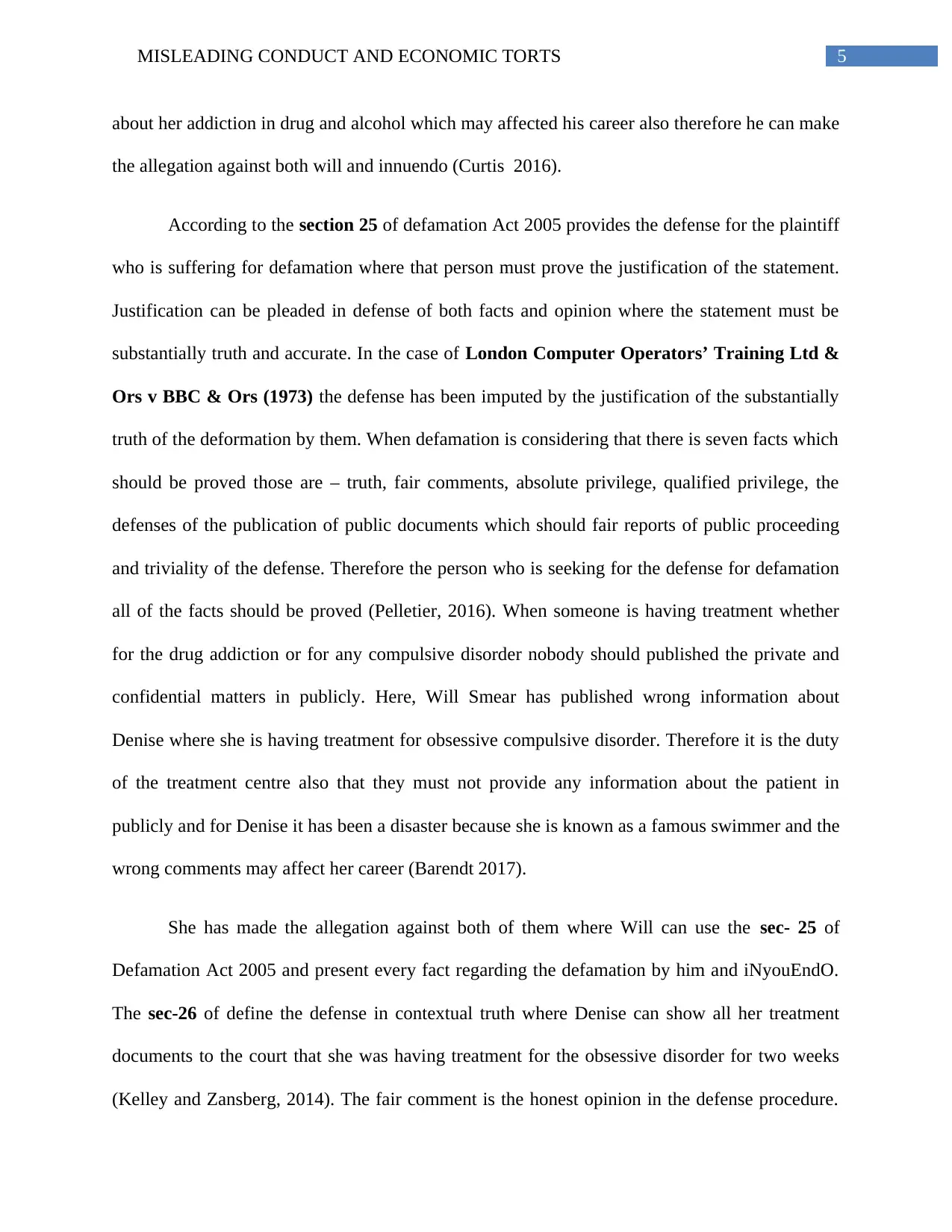
5MISLEADING CONDUCT AND ECONOMIC TORTS
about her addiction in drug and alcohol which may affected his career also therefore he can make
the allegation against both will and innuendo (Curtis 2016).
According to the section 25 of defamation Act 2005 provides the defense for the plaintiff
who is suffering for defamation where that person must prove the justification of the statement.
Justification can be pleaded in defense of both facts and opinion where the statement must be
substantially truth and accurate. In the case of London Computer Operators’ Training Ltd &
Ors v BBC & Ors (1973) the defense has been imputed by the justification of the substantially
truth of the deformation by them. When defamation is considering that there is seven facts which
should be proved those are – truth, fair comments, absolute privilege, qualified privilege, the
defenses of the publication of public documents which should fair reports of public proceeding
and triviality of the defense. Therefore the person who is seeking for the defense for defamation
all of the facts should be proved (Pelletier, 2016). When someone is having treatment whether
for the drug addiction or for any compulsive disorder nobody should published the private and
confidential matters in publicly. Here, Will Smear has published wrong information about
Denise where she is having treatment for obsessive compulsive disorder. Therefore it is the duty
of the treatment centre also that they must not provide any information about the patient in
publicly and for Denise it has been a disaster because she is known as a famous swimmer and the
wrong comments may affect her career (Barendt 2017).
She has made the allegation against both of them where Will can use the sec- 25 of
Defamation Act 2005 and present every fact regarding the defamation by him and iNyouEndO.
The sec-26 of define the defense in contextual truth where Denise can show all her treatment
documents to the court that she was having treatment for the obsessive disorder for two weeks
(Kelley and Zansberg, 2014). The fair comment is the honest opinion in the defense procedure.
about her addiction in drug and alcohol which may affected his career also therefore he can make
the allegation against both will and innuendo (Curtis 2016).
According to the section 25 of defamation Act 2005 provides the defense for the plaintiff
who is suffering for defamation where that person must prove the justification of the statement.
Justification can be pleaded in defense of both facts and opinion where the statement must be
substantially truth and accurate. In the case of London Computer Operators’ Training Ltd &
Ors v BBC & Ors (1973) the defense has been imputed by the justification of the substantially
truth of the deformation by them. When defamation is considering that there is seven facts which
should be proved those are – truth, fair comments, absolute privilege, qualified privilege, the
defenses of the publication of public documents which should fair reports of public proceeding
and triviality of the defense. Therefore the person who is seeking for the defense for defamation
all of the facts should be proved (Pelletier, 2016). When someone is having treatment whether
for the drug addiction or for any compulsive disorder nobody should published the private and
confidential matters in publicly. Here, Will Smear has published wrong information about
Denise where she is having treatment for obsessive compulsive disorder. Therefore it is the duty
of the treatment centre also that they must not provide any information about the patient in
publicly and for Denise it has been a disaster because she is known as a famous swimmer and the
wrong comments may affect her career (Barendt 2017).
She has made the allegation against both of them where Will can use the sec- 25 of
Defamation Act 2005 and present every fact regarding the defamation by him and iNyouEndO.
The sec-26 of define the defense in contextual truth where Denise can show all her treatment
documents to the court that she was having treatment for the obsessive disorder for two weeks
(Kelley and Zansberg, 2014). The fair comment is the honest opinion in the defense procedure.
⊘ This is a preview!⊘
Do you want full access?
Subscribe today to unlock all pages.

Trusted by 1+ million students worldwide
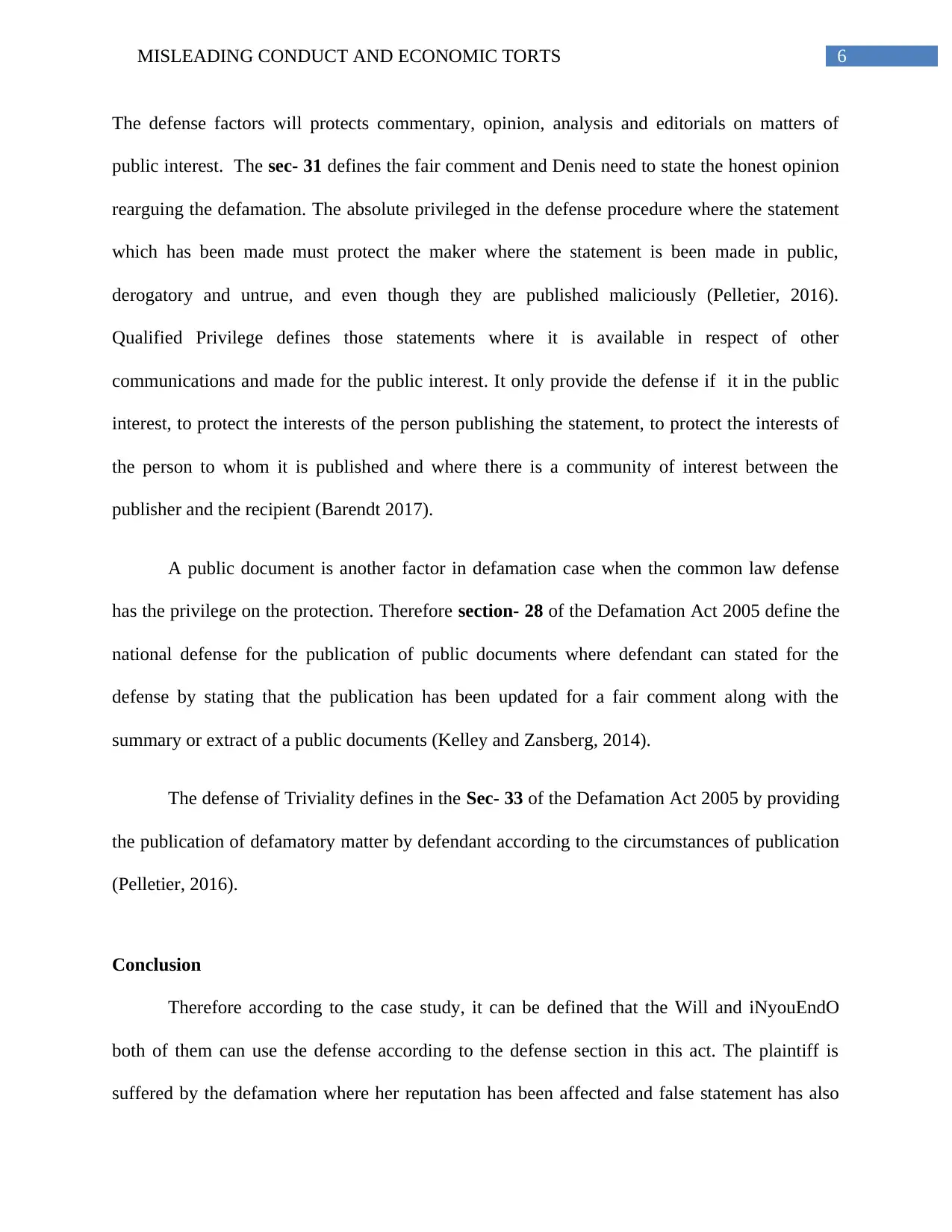
6MISLEADING CONDUCT AND ECONOMIC TORTS
The defense factors will protects commentary, opinion, analysis and editorials on matters of
public interest. The sec- 31 defines the fair comment and Denis need to state the honest opinion
rearguing the defamation. The absolute privileged in the defense procedure where the statement
which has been made must protect the maker where the statement is been made in public,
derogatory and untrue, and even though they are published maliciously (Pelletier, 2016).
Qualified Privilege defines those statements where it is available in respect of other
communications and made for the public interest. It only provide the defense if it in the public
interest, to protect the interests of the person publishing the statement, to protect the interests of
the person to whom it is published and where there is a community of interest between the
publisher and the recipient (Barendt 2017).
A public document is another factor in defamation case when the common law defense
has the privilege on the protection. Therefore section- 28 of the Defamation Act 2005 define the
national defense for the publication of public documents where defendant can stated for the
defense by stating that the publication has been updated for a fair comment along with the
summary or extract of a public documents (Kelley and Zansberg, 2014).
The defense of Triviality defines in the Sec- 33 of the Defamation Act 2005 by providing
the publication of defamatory matter by defendant according to the circumstances of publication
(Pelletier, 2016).
Conclusion
Therefore according to the case study, it can be defined that the Will and iNyouEndO
both of them can use the defense according to the defense section in this act. The plaintiff is
suffered by the defamation where her reputation has been affected and false statement has also
The defense factors will protects commentary, opinion, analysis and editorials on matters of
public interest. The sec- 31 defines the fair comment and Denis need to state the honest opinion
rearguing the defamation. The absolute privileged in the defense procedure where the statement
which has been made must protect the maker where the statement is been made in public,
derogatory and untrue, and even though they are published maliciously (Pelletier, 2016).
Qualified Privilege defines those statements where it is available in respect of other
communications and made for the public interest. It only provide the defense if it in the public
interest, to protect the interests of the person publishing the statement, to protect the interests of
the person to whom it is published and where there is a community of interest between the
publisher and the recipient (Barendt 2017).
A public document is another factor in defamation case when the common law defense
has the privilege on the protection. Therefore section- 28 of the Defamation Act 2005 define the
national defense for the publication of public documents where defendant can stated for the
defense by stating that the publication has been updated for a fair comment along with the
summary or extract of a public documents (Kelley and Zansberg, 2014).
The defense of Triviality defines in the Sec- 33 of the Defamation Act 2005 by providing
the publication of defamatory matter by defendant according to the circumstances of publication
(Pelletier, 2016).
Conclusion
Therefore according to the case study, it can be defined that the Will and iNyouEndO
both of them can use the defense according to the defense section in this act. The plaintiff is
suffered by the defamation where her reputation has been affected and false statement has also
Paraphrase This Document
Need a fresh take? Get an instant paraphrase of this document with our AI Paraphraser
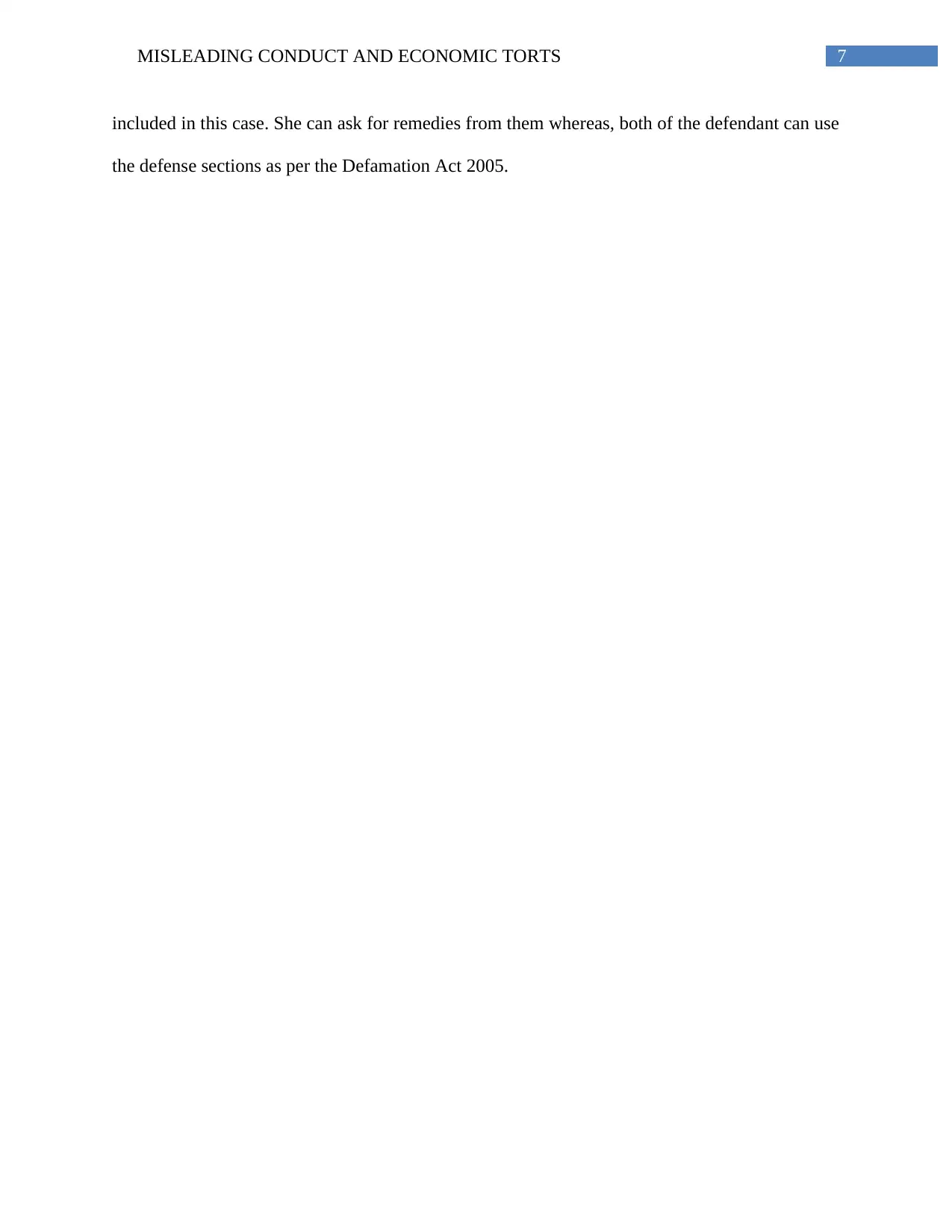
7MISLEADING CONDUCT AND ECONOMIC TORTS
included in this case. She can ask for remedies from them whereas, both of the defendant can use
the defense sections as per the Defamation Act 2005.
included in this case. She can ask for remedies from them whereas, both of the defendant can use
the defense sections as per the Defamation Act 2005.
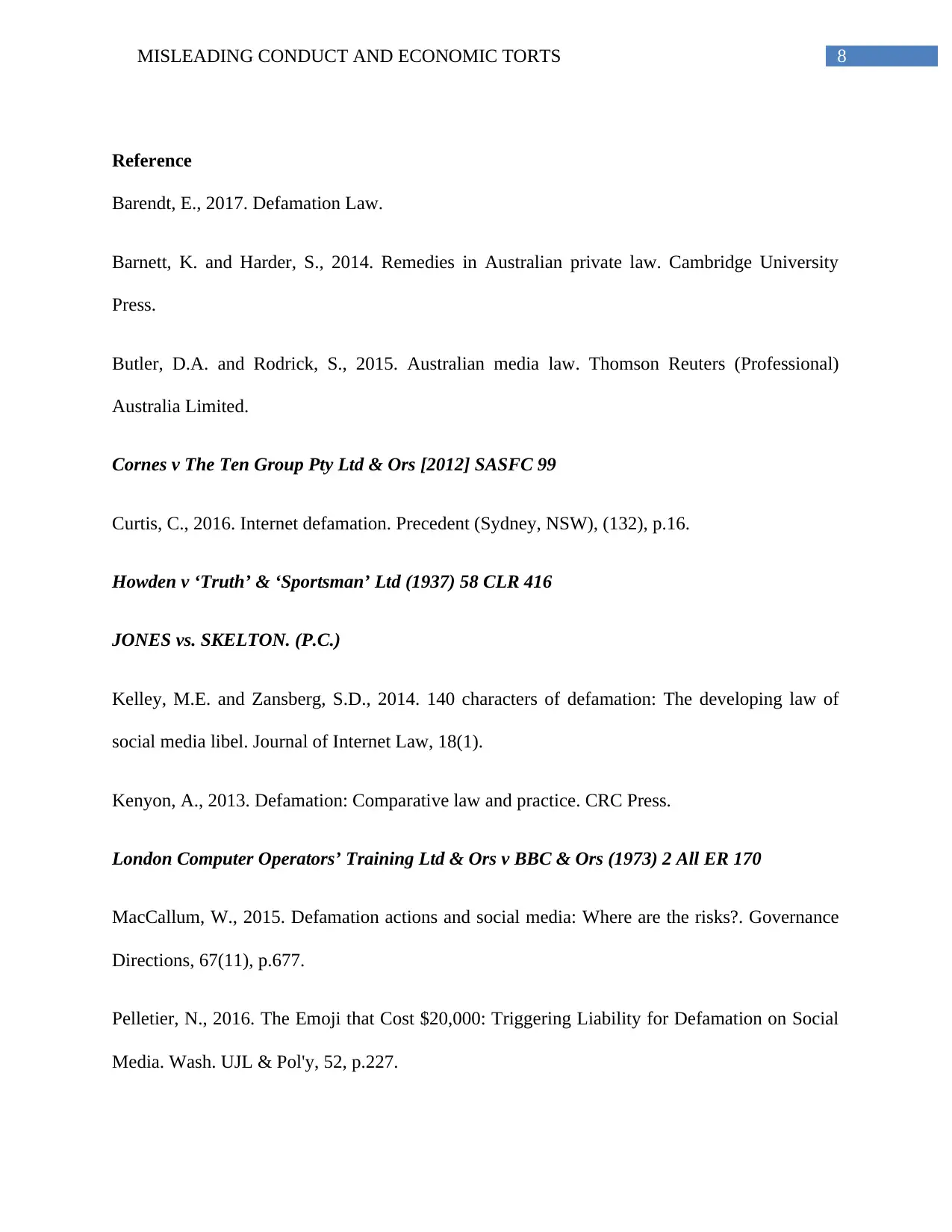
8MISLEADING CONDUCT AND ECONOMIC TORTS
Reference
Barendt, E., 2017. Defamation Law.
Barnett, K. and Harder, S., 2014. Remedies in Australian private law. Cambridge University
Press.
Butler, D.A. and Rodrick, S., 2015. Australian media law. Thomson Reuters (Professional)
Australia Limited.
Cornes v The Ten Group Pty Ltd & Ors [2012] SASFC 99
Curtis, C., 2016. Internet defamation. Precedent (Sydney, NSW), (132), p.16.
Howden v ‘Truth’ & ‘Sportsman’ Ltd (1937) 58 CLR 416
JONES vs. SKELTON. (P.C.)
Kelley, M.E. and Zansberg, S.D., 2014. 140 characters of defamation: The developing law of
social media libel. Journal of Internet Law, 18(1).
Kenyon, A., 2013. Defamation: Comparative law and practice. CRC Press.
London Computer Operators’ Training Ltd & Ors v BBC & Ors (1973) 2 All ER 170
MacCallum, W., 2015. Defamation actions and social media: Where are the risks?. Governance
Directions, 67(11), p.677.
Pelletier, N., 2016. The Emoji that Cost $20,000: Triggering Liability for Defamation on Social
Media. Wash. UJL & Pol'y, 52, p.227.
Reference
Barendt, E., 2017. Defamation Law.
Barnett, K. and Harder, S., 2014. Remedies in Australian private law. Cambridge University
Press.
Butler, D.A. and Rodrick, S., 2015. Australian media law. Thomson Reuters (Professional)
Australia Limited.
Cornes v The Ten Group Pty Ltd & Ors [2012] SASFC 99
Curtis, C., 2016. Internet defamation. Precedent (Sydney, NSW), (132), p.16.
Howden v ‘Truth’ & ‘Sportsman’ Ltd (1937) 58 CLR 416
JONES vs. SKELTON. (P.C.)
Kelley, M.E. and Zansberg, S.D., 2014. 140 characters of defamation: The developing law of
social media libel. Journal of Internet Law, 18(1).
Kenyon, A., 2013. Defamation: Comparative law and practice. CRC Press.
London Computer Operators’ Training Ltd & Ors v BBC & Ors (1973) 2 All ER 170
MacCallum, W., 2015. Defamation actions and social media: Where are the risks?. Governance
Directions, 67(11), p.677.
Pelletier, N., 2016. The Emoji that Cost $20,000: Triggering Liability for Defamation on Social
Media. Wash. UJL & Pol'y, 52, p.227.
⊘ This is a preview!⊘
Do you want full access?
Subscribe today to unlock all pages.

Trusted by 1+ million students worldwide
1 out of 9
Related Documents
Your All-in-One AI-Powered Toolkit for Academic Success.
+13062052269
info@desklib.com
Available 24*7 on WhatsApp / Email
![[object Object]](/_next/static/media/star-bottom.7253800d.svg)
Unlock your academic potential
Copyright © 2020–2025 A2Z Services. All Rights Reserved. Developed and managed by ZUCOL.





